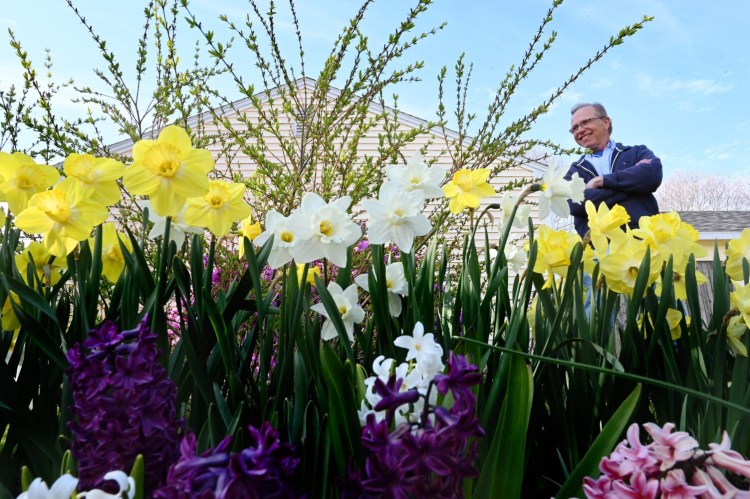Last March, when people were just beginning to realize that life as they had known it was going away for the foreseeable future, a little bit of brightness started popping up in our yards – and believe it or not, on social media.
Crocuses and iris reticulata began to bloom in our gardens. Friends began to post photos of the early blossoming bulbs on their properties. It brought us some brightness.
Part of the reason I saw so many photos is that my wife, Nancy, is president of the Cape Elizabeth Garden Club.
The club for decades had raised money through a plant sale for the scholarship it gives out each year: digging, dividing and re-potting plants from members’ gardens. But when winter moth hit town, the club could no longer hold the sale without running the risk of the winter moth eggs traveling in the soil of those potted plants to areas that were not yet affected by the pest.
So, the club turned to a bulb sale (the deadline has passed for this year), and I was put in charge of dealing with the bulb wholesaler. (I am also a garden club member; men may join.) As a result, I received many photographs of bulbs plants in blossom. Those photos have spurred me to plant a lot more bulbs myself this fall.
Now until the end of October is the recommended time to plant spring-flowering bulbs, though they can be planted anytime before the ground freezes and will still grow and bloom next spring.

Tulips come in a wide variety of colors and blossom shapes. Rich Abrahamson/Morning Sentinel Buy this Photo
Tulips and narcissus are the most popular bulbs to plant.
Most people call all narcissus daffodils, but technically daffodil is the larger-blossomed type of narcissus. Don’t worry about it. All are planted the same way, so look at the pictures on the package or bin at your local store or in the catalog, read the description and buy what you like. They come in different colors, mostly white and yellow with a bit of orange. Get some early bloomers and late bloomers, so you can spread out the show come spring.
Daffodils are a sturdy bulb, poisonous so pests like deer and rodents won’t eat them, and they will proliferate for years in your garden.
Tulips blossom later than daffodils, and have the advantage of coming in a wide variety of colors – one of my favorites is almost black – and many blossom shapes. They are not as long-lived as daffodils, and not only because various animals like to eat them. Even setting that aside, after a few years they may just stop appearing in your garden.
Some bulb authorities say that planting tulips deeper than label directions tell you to helps to keep them coming back each year. And some gardeners dig up their tulip bulbs once the blooms are spent, dry them and replant them in the fall. Admirable, but it seems like a lot of work to me.
Another favorite common bulb is allium, or ornamental onion. People who grow onions for food will notice that, if left to grow, onions produce flowers. The ornamental onions are bred to emphasize the flowers rather than the bulbs. Some alliums produce flowers that are a foot across. Others are much smaller, but all are bright and showy. A bonus: animals aren’t interested in eating onion-flavored blooms and bulbs.
Crocuses are the showiest early bloomers, sometimes popping up through the snow in late winter or early spring. White, yellow and varying shades of purple, they are a real pick-me-up at the very moment that gardeners are sick and tired of winter.
Those are just the common varieties of flowering bulbs. Among the others you can grow are hyacinth, muscari, camassia, fritillaria, anemone, iris reticulata and chionodoxa. But if you are new to the idea of spring-flowering bulbs, the four top ones will get you started.
Now some tips on planting.

More is better when it comes to planting bulbs. Nothing says lonely like a sole crocus or daffodil. Photo by Peggy Grodinsky
First, more is better. There is nothing sadder than a single daffodil or tulip blossoming in a garden. It looks lonely. A patch of at least three in an area of a square foot is the minimum I would recommend, but a large area of flowering bulbs, with the plants about six inches apart, is stunning.
And remember, you don’t have to plant bulbs instead of your perennial flowering plants. Because the bulbs will blossom and the stems and foliage will begin to fade before your perennials come up, the plants can share the same garden space. The perennials will sometimes hide the dying foliage of the bulbs. Nothing is wrong with mixing bulbs, either. For a crowded cottage-garden effect, go ahead and put different bulbs together.
The standard recommendation is to plant the bulb three times as deep as the bulb is tall. In truth, deeper is better. It will be harder for pests to reach the edible bulbs, and the bulbs won’t get damaged when you are weeding or working on the other perennials in the space.
Normally watering isn’t required for bulbs, but it has been so dry this year I’d add a little when you plant. Bone meal used to be recommended as fertilizer, but no more. A good balanced fertilizer (close to equal part nitrogen, phosphorous and potassium) will give the bulbs a good head start.
I am hoping that this coming spring will be a lot less depressing than the previous one. But even if we must continue to spend more time trapped at home than ordinarily, more flowering bulbs will make the stay more enjoyable.
Tom Atwell is a freelance writer gardening in Cape Elizabeth. He can be contacted at: tomatwell@me.com.
Send questions/comments to the editors.


